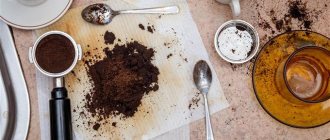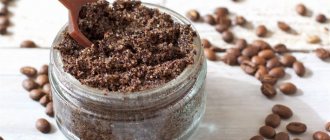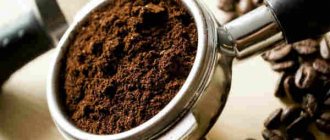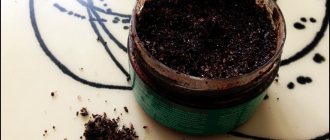Coffee invigorates not only people, but also plants! Coffee grounds as a fertilizer for the garden work just great! If you are an avid coffee drinker, do not rush to throw away the spent grounds. Make it “work” for your harvest with the help of our tips.
Many of us cannot imagine our morning without a cup of aromatic strong coffee. This black drink has a truly “magical” effect on the body: thoughts become clearer, performance and mood improve. Did you know that coffee can affect plants in much the same way? Of course, with proper use!
Coffee grounds as fertilizer
In every family, after morning coffee there is cake left over, which is simply poured down the drain. It turns out that this is an excellent fertilizer that is successfully used in gardening and gardening.
Not all gardeners know that dormant coffee can bring many benefits to plants, so they do not use this valuable gift of nature.
Coffee beans contain nitrogen, iron, potassium, phosphorus, and B vitamins. All these elements contribute to good plant growth, the formation of tasty fruits or lush flowering of a flower bed in the country.
Many gardeners are afraid of acidifying the soil, but drunk coffee has a neutral pH level. The ground grains release all the acid into the drink, so the cake contains a negligible amount of acid that cannot harm the garden soil.
How is dried cake useful for the soil in the country? It attracts earthworms, which loosen the soil, making it lighter and more convenient for oxygen enrichment. At the same time, the aroma of coffee repels many pests.
Important! You can only use drunk coffee that has released acid into the drink.
It is better not to use thermally untreated grains, since they contain a lot of acids that will make the soil acidic.
Using leftover coffee
To use the drink sediment as fertilizer, it must be properly collected. The cake remaining after cooking is collected, then thoroughly dried, and placed in a linen bag so that it “breathes.” If the leftovers are not dried well, then mold may appear in them, and this is already very bad.
Remember. Do not use moldy coffee grounds.
How to use the sediment from ground beans?
Can be used to feed plants, starting with seedlings. The soil for seedlings must be mixed with dried waste from the drink, then the soil will become light and loose, which will be the best condition for growth for tender sprouts.
It has been noticed that seeds in such soil hatch faster, and seedlings grow stronger. The main thing is to prevent the soil from drying out, because loose soil loses moisture faster.
Benefits for the garden
- The remains after cooking can be used for mulching. To do this, a small amount of grounds is mixed with soil, sawdust, and the soil is simply sprinkled around the plant stem.
- To produce compost enriched with nutrients.
- The aroma of the harvest is not tolerated by many insects, so it serves as an excellent barrier to pests in gardens and vegetable gardens.
- When replanting plants, sprinkle the cake mixed with soil well into the holes.
- Fragrant precipitation is used in the form of mulch. But you shouldn’t sprinkle them thickly around the plants, otherwise they will “blind” so that they won’t let air through to the roots of the plants.
- To improve drainage on heavy soils.
Scarecrow for cats
The fragrant collection repels cats that like to dig holes in the beds.
The sensitive nose of pets will immediately sense an unpleasant aroma. To prevent cats and dogs from spoiling the garden beds, prepare the following solution: mix coffee sediment with 2 drops of rosemary oil, orange oil, or citrus zest, and place it where animals like to dig. They won't come there anymore.
Recommendations for preparation
When collecting coffee grounds, you need to dry them, evenly distributing them in a thin layer on a sheet of paper.
During the warm season, the spent coffee can be immediately poured into the garden or vegetable garden. From autumn to spring it is collected and dried. It is important to spread the powder in a thin layer on a piece of paper or cloth to prevent it from molding. Otherwise, it will become unsuitable as a fertilizer.
Some gardeners advise calcining the grounds in the oven, and after cooling, put them in plastic bags and store them in a dry place until use.
If possible, coffee is immediately placed in compost in any season. This can be done by those who permanently live on the site or come to the dacha at any time of the year.
Read more about the use of healthy cake.
Compost with coffee grounds
When you accumulate leftovers from an invigorating drink, use them to compost. When placed in compost, dormant coffee beans begin to function as nitrogen elements. They are the ones who start the combustion process and maintain the temperature inside the compost heap that helps plant debris to decompose better.
Sometimes gardeners specifically purchase grounds from nearby coffee shops, then spread the layers in compost. The aromatic collection is mixed with soil, leaves, straw, then sprinkled with plant debris in the compost heap. For greater benefit, you can send vermicompost there. Such compost will be the best organic fertilizer for garden plantings.
For seedlings
After picking, the seedlings are mulched with a thin layer of sleeping, thoroughly dried coffee.
A light, infertile mixture of peat and sand is used in a 1:1 ratio (find out → how to use peat as a plant food + reviews). Spent coffee powder is added to the substrate, which should not exceed one fifth of the total soil.
It is important to use finely ground grounds and dry them thoroughly.
Seeds that germinate under a greenhouse cover in a warm, humid environment are susceptible to disease.
If the coffee is wet, it will lead to mold and death of the seedlings. Therefore, it is necessary to monitor the condition of the crops and remove unwanted formations in a timely manner. They are easily removed by hand. From time to time, containers with seedlings need to be ventilated.
Coffee fertilizer
Many gardeners use the aromatic collection as fertilizer for all plants grown on the site. It is worth noting right away that coffee residues cannot replace complex or other fertilizers.
Indeed, cake contains nitrogen, phosphorus, and calcium, but only in small quantities. And all the elements do not immediately enter the soil, as they decompose very slowly. Therefore, along with coffee cake, it is worth adding other fertilizers.
But to improve the quality of the soil and attract worms, the remains will undoubtedly be very useful. It is worth noting that pouring instant coffee under plants is not recommended, otherwise acidification of the soil will occur.
The use of uncooked ground grains as fertilizer is also not recommended. For fertilizer, only the dried cake after brewing coffee is used.
Chemical composition
The nitrogen content in coffee is not sufficient for complete nutrition and requires additional fertilizers.
Carbamide (urea) is a good mineral fertilizer. Dry coffee contains about 2% nitrogen. Compared to other fertilizers, this amount is too small for feeding. In addition, the substance dissolves slowly, so other nitrogen-containing fertilizers have to be added. It is better if it is organic:
- Humus → how to apply it as fertilizer,
- Mulch → what can be mulched, types,
- Compost → how to make it yourself.
In addition to nitrogen, the composition includes potassium, magnesium, iron, without which full physiological processes in plant life are impossible.
How to feed flowers
If you grow roses in the garden, then coffee fertilizer will be very useful for roses. Dry waste should be mixed with chopped grass and sprinkled on the flowerbed. You can add it to the water you use to water your roses. With this fertilizer, the rose bushes will be covered with new buds.
For rose bushes, the grounds can be added to the top layer of soil. It will make it loose and light, which will facilitate the flow of oxygen to the roots.
Rose bushes that receive magnesium, phosphorus and nitrogen will slightly change the color of the buds. This phenomenon is interesting to observe. If you do not want the color of the roses to change, then it is better not to water them with a solution containing grounds.
To make tulips, peonies, lilies, and hostas bloom longer, you can also use ground brewed coffee.
Coffee grounds are not only a top dressing for these flowers, but also a way to enhance the color of the foliage and improve the decorative appearance of the buds.
When to feed garden flowers: the first time in early April, when the first shoots appear, and then every 2-3 weeks. This feeding is useful not only for plant growth, but also for repelling snails that like to feast on flower bulbs.
Feeding indoor plants with dormant waste will also give good results. When to apply cake to indoor plants:
- When transplanting into another pot. Mix dry waste with soil, put it in a pot, then plant the plants.
- When you first plant a new plant.
- Once a month you can fertilize with dried grounds to eliminate the possibility of midges. You should also wait until the top layer of soil dries after the last watering.
- To prevent the flowers from changing the color of the foliage and buds, you should water them with the same water in which the coffee residues were infused.
For garden and vegetable crops in open ground
Potatoes, tomatoes, eggplants
Coffee powder is placed in each hole when planting nightshade crops. The thicket is evenly mixed with a small amount of soil, which is sprinkled on the roots. The ratio should not exceed 1:5.
In further care, fertilizing is used as mulch, spreading the spent coffee in a thin layer on the surface of the soil, around each bush within a radius of 10 cm.
At the same time, you need to make sure that there are not too many geese. Large thickness leads to compaction and rotting of the fertilizer. Instead of benefit, harm results. This will not happen if the coffee is mixed with dry compost material in advance:
- Mown and dried grass (⊕ use of green grass as fertilizer),
- Straw,
- Koroy,
- Wood chips.
Fertilizing the soil for growing crops of the Solanaceae family is carried out 2 times a year, in the spring before planting and in the fall after harvesting.
Radishes, carrots, beets, turnips
Coffee is a good helper when growing root crops; the potassium and magnesium it contains have a beneficial effect on the taste of the tubers.
Fertilizer is applied before sowing seeds on a pre-dug bed.
It is better to do the work in this order:
| Step 1. | Using pegs and string, mark out an even row for sowing. |
| Step 2. | Form a small strip along the marking, 1 cm deep. |
| Step 3. | Distribute the coffee grounds evenly in the furrow, mix them with the soil and water. |
| Step 4. | Place the seeds in the prepared bed. |
| Step 5. | Sprinkle the mixture of soil and grounds on top and compact lightly. There is no need to water from above, otherwise the seeds may move out of place. |
When shoots appear and grow to two or three true leaves, the crop can be mulched with a mixture of compost and coffee.
For the bow
This crop requires a large amount of nitrogen. Of course, you can use mineral fertilizers, which will make the heads larger, but then the onions will be stored worse. If you use organic matter, the size of the root crops will be smaller, but they will be preserved longer.
Proponents of ecological farming advise using organic fertilizers - humus or compost. Before planting onions, mix them with soil and well-dried coffee grounds. You will need two glasses per square meter. This feeding will be enough for the entire growing season.
Do not throw away the contents of the coffee machine
The sediment from the coffee machine will also help garden and vegetable plants and repel many pests from the garden. It is effective against slugs, ants, carrot flies, and snails.
If dormant sediment is scattered around plants, it will become a barrier to slugs, ants and snails. And to get rid of aphids, you need to spray all the plants that are covered with a sticky coating. A solution containing coffee will also repel ants that carry this pest.
Coffee grounds are also successfully used against ants. Sprinkle the dried cake on the approaches to the anthill and the insects will leave their homes. Do not cover the approaches too thickly; the ants will already smell an unpleasant odor.
Coffee residues introduced into the soil will also repel the larvae of those insects that eat root crops.
How to prepare the solution: waste, approximately 200 g, pour 0.5 liters of hot water, let it brew for 3-4 hours. Then the bushes of roses, strawberries, cabbage, and carrots are sprayed.
Category: “Questions and answers”
Question number 1 . Can coffee be used on indoor plants?
Absolutely yes. For most home flowers, a mixture of peat, sand and organic fertilizer is prepared. Coffee cake goes well with these components as one of the ingredients for planting. In further care, the surface of the substrate can be covered with a thin layer of coffee powder. At the same time, you need to make sure that the mulch does not become moldy. If this happens, the fertilizer should be removed and replaced with another portion.
Question No. 2.
There is an opinion that garden pests do not like coffee. How do earthworms feel about it?
The smell of coffee attracts these soil inhabitants, who actively participate in the creation of humus. This is another argument in favor of a healthy drink in the garden.











